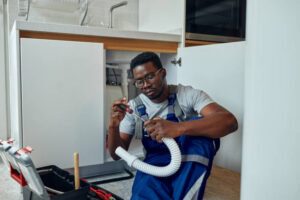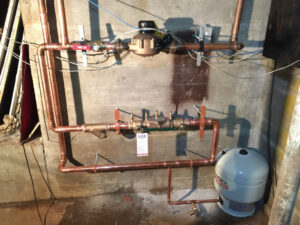Plumber Bucks County are responsible for installing, maintaining, and troubleshooting plumbing systems. They are usually employed by construction firms or work as independent contractors. They often use specialized equipment and tools to perform their duties.

Plumbers collaborate with other professionals, such as construction teams and architects, to ensure that plumbing systems are integrated seamlessly into building projects. They also interpret blueprints and plans to ensure plumbing systems comply with local and national regulations.
Plumbing is a hands-on career that allows you to work on various projects. It also offers excellent job stability and earning potential for skilled professionals. You will work on residential and commercial plumbing projects, repairing and installing water heaters, toilets, sinks, faucets, bathtubs and other appliances. Your responsibilities also include interpreting blueprints and building codes to determine the best placement for plumbing systems in new construction.
Plumbers often work on call for emergency jobs, so they must be available during weekends and evenings to address problems. They may travel to various job sites and must be able to fit into tight spaces in homes and buildings. In addition, the physical nature of the work can be demanding and require you to frequently bend and kneel for extended periods of time.
Most plumbers work for large plumbing companies but some choose to become self-employed and operate their own plumbing businesses. Some even open their own restaurants or retail stores with plumbing services available to customers. Those who choose to work for themselves can set their own hours and enjoy the flexibility of choosing what types of projects they want to take on.
Plumbers who choose to be self-employed are required by their state to obtain a license after completing an apprenticeship training program that typically lasts four years. Apprenticeship programs mix classroom instruction with supervised work experience under a licensed journeyman plumber. In some states, you may need to pass a background check and drug test before becoming licensed. Regardless of whether you are employed or self-employed, you must adhere to occupational safety standards and keep your tools and equipment well-maintained. You must also follow proper work practices when handling chemicals and sewage waste. This includes keeping cutting instruments sharp and storing them safely, taking care not to touch any exposed electrical wires and disposing of oily rags appropriately. You must also regularly wear protective gear such as gloves and eyewear to prevent injuries from hazardous materials or debris. You must also maintain a clean working area and regularly empty waste containers to avoid environmental hazards.
Job Duties
A plumber works on systems that transport water, steam and other liquids, as well as waste and sewage. These systems include bathtubs, toilets, sinks and showers. Plumbers also repair and install gas lines and drainage pipes. They must be able to read blueprints and plans to correctly size pipes for the job. They also use saws to cut holes in walls and floors, as well as pipe cutters to shape pipes precisely. Plumbers must be physically fit to handle the tools they use, and they may need to climb stairs or ladders in some jobs.
Plumbing work is performed in many settings, from homes to commercial buildings and construction sites. Some of the more common duties include inspecting existing pipe work to assess damage, pressure levels and locate blockages; installing piping systems and fixtures including toilets, faucets, urinals, sinks and drains; connecting kitchen appliances such as dishwashers and washing machines to plumbing fixtures; and testing backflow prevention devices. Plumbers also perform routine maintenance tasks such as cleaning drains and toilet traps, flushing valves, hot water heaters and sump pumps.
Interpreting building codes and regulations, preparing work cost estimates and contracts, and performing regular safety inspections are also part of the plumber’s job. Plumbers must be able to communicate with customers to understand their plumbing needs and provide advice, recommendations and repair options. This can require the plumber to interact with clients in a face-to-face environment as well as over the phone or internet.
Some plumbers specialize in certain types of projects, such as installing gas piping systems or working with high-pressure pipes in industrial settings. Other plumbers focus on specific types of fixtures, such as tubs and toilets. Still others are expert in specific types of plumbing problems, such as clogged drains or sewer issues. In these cases, the plumber must be able to correctly diagnose and fix the problem in order to keep the customer happy.
Education and Training Requirements
A plumber is responsible for the installation, repair and maintenance of the pipes that deliver water, gas and waste in residential, commercial and industrial settings. This is a trade that requires specialized training and certification. There are a number of ways that one can gain the necessary qualifications to become a plumber. These include formal apprenticeship, a vocational school program or a combination of both.
Plumbing schools typically offer courses that focus on pipe system design, safety protocols and blueprint reading. They also provide hands-on training in the skills needed to work as a plumber. Depending on the school, these courses can be completed in as few as five years. A high school diploma is usually required before enrolling.
Once a person has obtained the necessary education and training, they can apply to join an apprenticeship program with a master plumber. Apprenticeship programs can take several years to complete and are typically funded by local governments or unions. Upon completion, an apprentice can earn their journeyman license. Journeymen must pass a licensing exam to demonstrate their knowledge of plumbing codes, materials and techniques. Some jurisdictions may require a minimum number of years of work experience as an apprentice before granting this license.
After becoming a licensed plumber, they must stay up to date on new technologies and equipment. This is important because plumbing systems are complex and continually changing. Plumbers can also choose to obtain additional professional certifications, which may improve their marketability or help them find employment.
Soft skills are important for success in this profession. Plumbers must be able to listen well to customers and understand their problems in order to determine the best solution. Plumbers should also be able to think critically and weigh the pros and cons of different options before making a decision. In addition, they must be able to perform physically demanding tasks on their feet for long periods of time and work with hand tools.
Many people choose to become a plumber because it is a rewarding career that pays well and offers good benefits. However, this is not a job for everyone, especially those who do not enjoy working with their hands or being on their feet for extended periods of time. In addition, plumbers must be willing to work evenings and weekends and be on call for emergency situations.
Salary
A plumber is a skilled tradesperson who installs, repairs and maintains pipes and plumbing fixtures in homes, businesses, industrial buildings and construction sites. They can work as employees of plumbing companies or as independent contractors. They are patient individuals with a practical mind and manual dexterity, capable of working efficiently with great attention to detail.
The salary of a plumber can vary depending on state, region and employer. For example, a plumber in Hawaii may earn more than one in Effingham, Illinois. This is because wages are usually based on the number of hours worked and the skill level of the plumber.
Plumbers can also earn more by completing specialized services, such as hydro jetting or trenchless sewer repair. These services can command higher rates since they require specialized equipment and training.
Plumbing is a field that is constantly evolving, and plumbers must be able to adapt and embrace new technologies and methods as they become available. For instance, new tools and software can make it easier for plumbers to identify problems, and they can also help them save time by reducing the amount of labor required.
Many plumbers have a strong customer service focus and are committed to providing excellent service. This can help them build loyal client bases and increase their revenue. Other ways to increase a plumber’s income include acquiring additional certifications, pursuing a management role and taking on new projects.
Plumbers typically work a standard 40-hour workweek, but they may be expected to work overtime during peak periods. In addition, they must be willing to travel to different jobsites and be exposed to various weather conditions.
The job outlook for plumbers is positive, and the demand for their services continues to grow. However, there is a shortage of qualified plumbers, and this is driving up wages. In addition, a lack of trained apprentices is making it difficult for plumbing companies to meet demand. Consequently, some plumbers are starting their own plumbing companies to take advantage of the lucrative opportunities available. Nevertheless, it is important to note that starting a plumbing company requires significant upfront investment and can be very risky.

